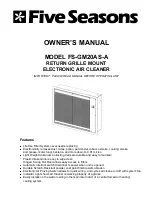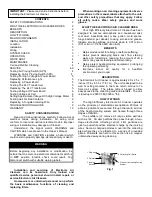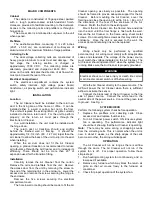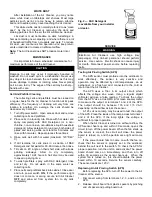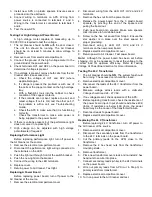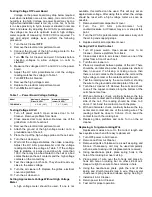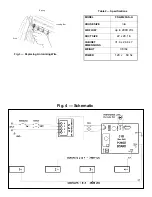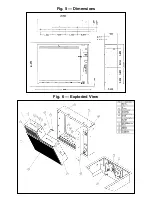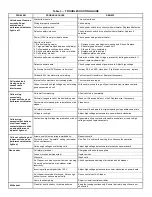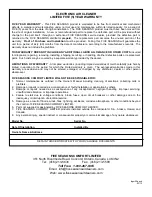
Table 3 — TROUBLESHOOTING GUIDE
PROBLEM
PROBABLE CAUSE
REMEDY
System fan is not on.
Turn system fan on.
Wiring improperly connected.
Check wiring.
Defective power switch.
Check power switch for continuity with multimeter. Replace if defective.
Defective safety interlock.
Check interlock switch for continuity with multimeter. Replace if
defective.
Power (120 V) is not provided to device.
Check power wiring with multimeter.
Short in cells due to:
1. Broken ionizing wire(s).
2. Large particles wedged between cell plate(s).
3. Cells washed recently and are still wet.
4. Round end plate insulator is burnt or melted.
5. Cell plate(s) are bent.
1. Remove wire or wire fragments, spring and S-hook. Replace.
2. Shake large particles out or wash cell.
3. Allow cells to dry completely.
4. Replace end plate insulator.
5. Straighten plates with pliers.
Defective performance indicator light.
Determine whether high voltage is present by testing power board. If
present, replace indicator light.
Defective power board.
Check components ahead of power board. Adjust high voltage
Air Proving Switch (APS) sensor is burnt out.
Jumper 3 & 4 on APS, close door. If light does not come on, replace
Off board 24 V transformer is not working.
Verify output of transformer. Replace if necessary.
Internal cell contacts are not touching plates.
Test contacts and repair.
Copper contacts on high voltage tray not making
good connection on cell.
With needle-nose pliers, gently pull contacts up or replace contacts.
Cells wet from washing.
Allow cells to dry completely.
Particle(s) lodged in cell or broken ionizing wire. Wash cell. Shake particle out of cell. Replace wire, if necessary.
Ducts were not cleaned prior to installation of air
cleaner.
Clean ducts.
Cell plate(s) are bent.
Remove cells and adjust to original spacing using needle-nose pliers.
Voltage is too high.
Adjust high voltage potentiometer on power board clockwise.
Contacts on high voltage tray are broken or bent. If possible, pull up contacts with needle-nose pliers or remove high
voltage tray and replace contacts.
Arrow on cell(s) not pointing towards back.
Reposition cells.
System fan is on “Automatic” setting (air cleaner
not on continuously)
Use “Fan On” system fan setting for continuous fan operation.
Not enough voltage on collecting cells.
Adjust high voltage potentiometer clockwise on power board.
Ozone odor
Cell plate(s) are bent.
Straighten with needle-nose pliers.
Loose or broken ionizing wire(s).
Replace wires.
Dirty cells.
Wash cells.
Air Cleaner is on when system fan is not running.
Air switch not activated or air cleaner wired
incorrectly.
Check operation and wiring of air switch and air cleaner.
Incoming voltage is higher than 120 V.
Adjust high voltage potentiometer counter-clockwise on power board.
Air Cleaner is oversized for house. Not enough
airflow to cover surface area of cells.
Use correct size of Air Cleaner.
Home is extremely dry.
Repair or install central humidifier.
Clean lint dust too heavy to remain airborne.
Keep fan running continuously. Ensure that return air grilles are not
obstructed.
Unit does not function
correctly. Power
switch on and
performance indicator
light is off.
Cell makes loud
hissing noise or
causes radio
interference.
Cells arcing
excessively
(power switch on and
performance indicator
Cells not collecting dirt
(power switch on and
performance indicator
light on).
White dust
Cells arcing
excessively at bottom
of cell near copper
contacts (power switch
on and performance
indicator light on).

